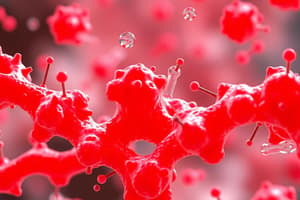Podcast
Questions and Answers
The movement of molecules from an area of higher concentration to an area of lower concentration is called?
The movement of molecules from an area of higher concentration to an area of lower concentration is called?
Diffusion
Which of the following is not true of an enzyme?
Which of the following is not true of an enzyme?
- Enzymes speed up chemical reactions
- Enzymes are specific to substrates
- Enzymes supply energy to start a chemical reaction (correct)
- Enzymes are consumed in reactions
Phospholipid molecules in a membrane are arranged with their _ on the exterior and their _ on the interior.
Phospholipid molecules in a membrane are arranged with their _ on the exterior and their _ on the interior.
hydrophilic heads......hydrophobic tails
In osmosis, water always moves towards the _ solution, that is, towards solution with the _ solute concentration.
In osmosis, water always moves towards the _ solution, that is, towards solution with the _ solute concentration.
Which of the following enables a cell to pick up and concentrate a specific kind of molecule?
Which of the following enables a cell to pick up and concentrate a specific kind of molecule?
A cell uses energy released by _ reaction to drive the _ reaction that makes ATP.
A cell uses energy released by _ reaction to drive the _ reaction that makes ATP.
What is the energy of activation?
What is the energy of activation?
What does the laws of thermodynamics state regarding energy changes?
What does the laws of thermodynamics state regarding energy changes?
Living things transform kinetic energy into potential chemical energy in the _, when _ is made.
Living things transform kinetic energy into potential chemical energy in the _, when _ is made.
Why does heating interfere with the activity of an enzyme?
Why does heating interfere with the activity of an enzyme?
What does it mean that an enzyme is specific?
What does it mean that an enzyme is specific?
What is the diffusion of water across a selectively permeable membrane called?
What is the diffusion of water across a selectively permeable membrane called?
If a cell is like a factory, then enzymes are like _, the plan for the factory.
If a cell is like a factory, then enzymes are like _, the plan for the factory.
What happens to a molecule that has the same shape as the substrate of an enzyme?
What happens to a molecule that has the same shape as the substrate of an enzyme?
What happens to a plant cell placed in a hypertonic solution?
What happens to a plant cell placed in a hypertonic solution?
How does a white blood cell release antibody molecules?
How does a white blood cell release antibody molecules?
Which of the following would be least likely to diffuse through a cell membrane without the help of a transport protein?
Which of the following would be least likely to diffuse through a cell membrane without the help of a transport protein?
Red blood cells shrivel when placed in a 10% sucrose solution. When first placed in a solution, the solute concentration of the cells is _ the concentration of the sucrose solution.
Red blood cells shrivel when placed in a 10% sucrose solution. When first placed in a solution, the solute concentration of the cells is _ the concentration of the sucrose solution.
After the cells shrivel, their solute concentration is _ the concentration of the sucrose solution.
After the cells shrivel, their solute concentration is _ the concentration of the sucrose solution.
How do large protein molecules from a nursing infant's mother's milk enter the cells lining the baby's digestive tract?
How do large protein molecules from a nursing infant's mother's milk enter the cells lining the baby's digestive tract?
What function does sodium ions serve in relation to certain enzymes involved in ATP hydrolysis?
What function does sodium ions serve in relation to certain enzymes involved in ATP hydrolysis?
The relationship between an enzyme's active site and its substrate is most like which of the following?
The relationship between an enzyme's active site and its substrate is most like which of the following?
In which of the following do both examples illustrate kinetic energy?
In which of the following do both examples illustrate kinetic energy?
What is a difference between active transport (AT) and facilitated diffusion (FD)?
What is a difference between active transport (AT) and facilitated diffusion (FD)?
In what way are an enzyme and a membrane receptor molecule similar?
In what way are an enzyme and a membrane receptor molecule similar?
Flashcards are hidden until you start studying
Study Notes
Diffusion and Osmosis
- Diffusion: Movement of molecules from high concentration to low concentration.
- Osmosis: Diffusion of water across a selectively permeable membrane, moving towards hypertonic solutions (greater solute concentration).
Enzymes
- Enzymes do not provide the energy needed to start reactions; they facilitate them by lowering energy of activation.
- Enzymes are specific and only speed up particular chemical reactions.
- Heating can denature enzymes by altering their shape, hindering their function.
- Active site of an enzyme is analogous to a glove fitting a hand, emphasizing specificity.
Membrane Dynamics
- Phospholipid Arrangement: Hydrophilic heads face outward, while hydrophobic tails face inward within membranes.
- Receptor-mediated Endocytosis: Mechanism that allows cells to concentrate and absorb specific molecules.
- Exocytosis: Process through which large molecules like antibodies exit cells.
Energy and Metabolic Processes
- Energy transformation: Living organisms convert kinetic energy into potential chemical energy in chloroplasts, resulting in glucose formation.
- Exergonic Reactions: Energy-releasing reactions that drive endergonic reactions, which require energy.
- Disorder (Entropy): Increases whenever energy changes occur according to the laws of thermodynamics.
Transport Mechanisms
- Active transport requires ATP, whereas facilitated diffusion does not.
- Large polar molecules are least likely to diffuse through cell membranes unassisted.
Cell Responses to Solutions
- When a plant cell is in a hypertonic solution (more solute), it shrivels due to osmosis.
- Red blood cells placed in high sucrose solutions shrink as solute concentration equilibrates.
Immunology and Cell Function
- Antibodies from mother's milk enter a nursing infant's cells through endocytosis, acting as disease-fighting agents.
Cofactors and Enzyme Performance
- Sodium ions can act as cofactors necessary for certain enzymes to function effectively.
Types of Energy
- Kinetic energy examples include a ball rolling down a hill and heat.
Studying That Suits You
Use AI to generate personalized quizzes and flashcards to suit your learning preferences.




